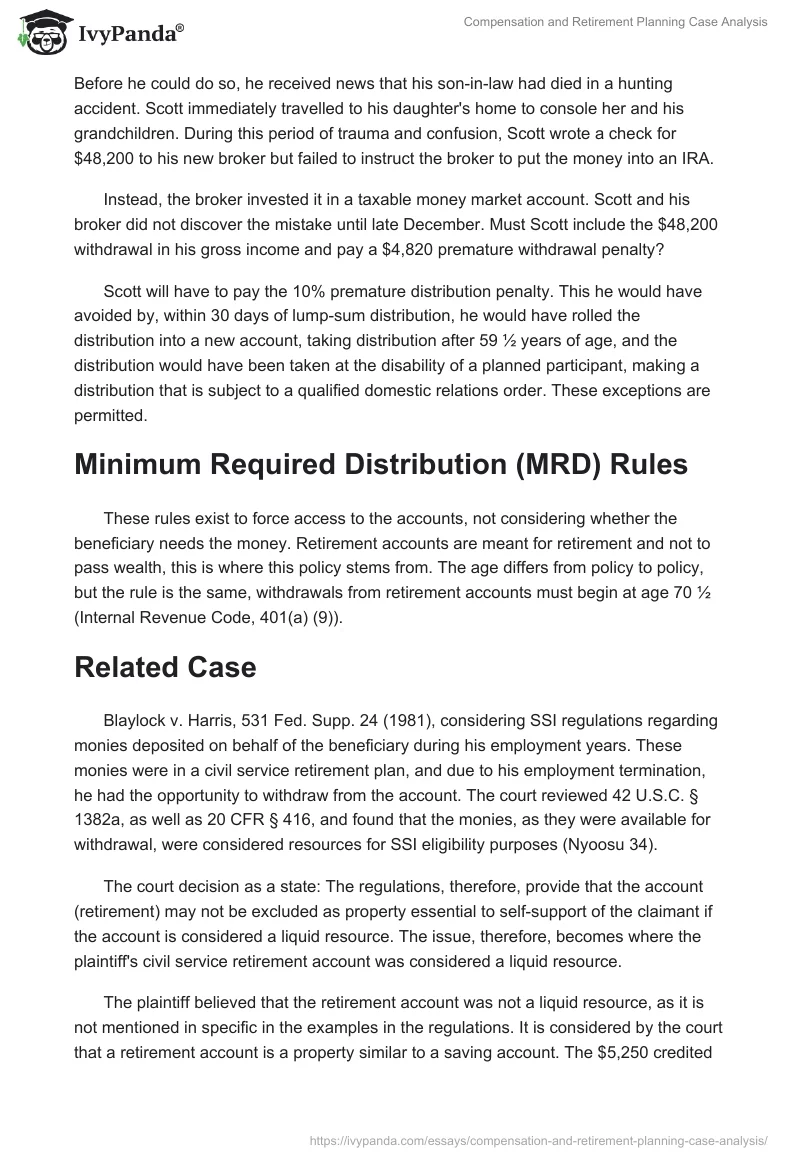Introduction
Compensation and retirement plans are referred to as employee benefits. They are values that are made available to the employee, for the services they offer to the organisation. These benefits or values are outside their regular payments. Compensation and retirement plans are referred to as tangible benefits. An example of a retirement plan is the IRA. Funds that are deposited into the IRA account are deducted by the employer from the employee’s payment and thus are not subjected to income taxation immediately. Except in cases where there are premature withdrawers from such accounts. For example, if the employee’s gross pay is 50,000 and 5000 of the gross salary is directed into an IRS retirement account. This monies can be used to invest in the retirement fund.
Tax Law: Understanding the IRA Retirement Plan and Account
IRA (Individual Retirement Account) is established and operated by the employee or worker. Annual contributions into the account are excluded from his income. The account is often operated with the assistance of the employers. The current contribution scheme is, 3000 for 2002-2004, 4000 for 2005-2007, 5000 for2008 (Hule 126). Depending on the distribution, IRA is subject to tax rates. For instance, premature withdrawals from qualified funds are penalised.
Case Study
Early this year, Scott Lowe, age 54, became dissatisfied with the service he was receiving from the broker who managed his IRA. He requested a distribution of the $48,200 balance in the account and received a check for this amount from the broker on May 23. Scott planned to roll the distribution over into a new IRA with a different broker. Before he could do so, he received news that his son-in-law had died in a hunting accident. Scott immediately travelled to his daughter’s home to console her and his grandchildren. During this period of trauma and confusion, Scott wrote a check for $48,200 to his new broker but failed to instruct the broker to put the money into an IRA.
Instead, the broker invested it in a taxable money market account. Scott and his broker did not discover the mistake until late December. Must Scott include the $48,200 withdrawal in his gross income and pay a $4,820 premature withdrawal penalty?
Scott will have to pay the 10% premature distribution penalty. This he would have avoided by, within 30 days of lump-sum distribution, he would have rolled the distribution into a new account, taking distribution after 59 ½ years of age, and the distribution would have been taken at the disability of a planned participant, making a distribution that is subject to a qualified domestic relations order. These exceptions are permitted.
Minimum Required Distribution (MRD) Rules
These rules exist to force access to the accounts, not considering whether the beneficiary needs the money. Retirement accounts are meant for retirement and not to pass wealth, this is where this policy stems from. The age differs from policy to policy, but the rule is the same, withdrawals from retirement accounts must begin at age 70 ½ (Internal Revenue Code, 401(a) (9)).
Related Case
Blaylock v. Harris, 531 Fed. Supp. 24 (1981), considering SSI regulations regarding monies deposited on behalf of the beneficiary during his employment years. These monies were in a civil service retirement plan, and due to his employment termination, he had the opportunity to withdraw from the account. The court reviewed 42 U.S.C. § 1382a, as well as 20 CFR § 416, and found that the monies, as they were available for withdrawal, were considered resources for SSI eligibility purposes (Nyoosu 34).
The court decision as a state: The regulations, therefore, provide that the account (retirement) may not be excluded as property essential to self-support of the claimant if the account is considered a liquid resource. The issue, therefore, becomes where the plaintiff’s civil service retirement account was considered a liquid resource.
The plaintiff believed that the retirement account was not a liquid resource, as it is not mentioned in specific in the examples in the regulations. It is considered by the court that a retirement account is a property similar to a saving account. The $5,250 credited to the plaintiff retirement account was considered a liquid resource. As the plaintiff was entitled to a complete refund of the amount credited to his retirement account, he could convert the $5,250 credit to cash and use the cash for his support.
Conclusion
State agencies should act in a way consistent with the national policy as it relates to retirement savings. Instead of its present contradictory stand to the national policy. Sometimes, they implement policies that are even inconsistent with their regulations and state statutes. These cases are now further made confused by the Supreme Court “waiver” issued by Justice Ginsburg in the case of Wisconsin v. Blumer, 534 US 473 (2002), which permits the state to consider any policy not specifically prohibited by the Congress. Planning carefully, based on the understanding of both the tax and Medicaid implications will be of great assistance.
References
Hule Johnson. Compensation And Retirement. Abuja: Lande. (1999).
Nyoosu, James. Safe Retirement. Capetown: Oracle. (2002). Web.


